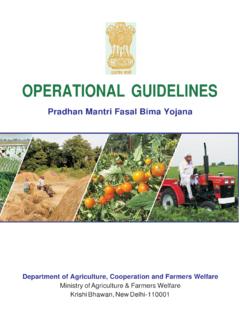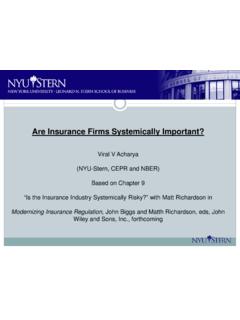Transcription of 2017 EY Canadian life insurance outlook - EY - …
1 2017 Canadian life insurance Outlook1| 2017 Canadian life insurance OutlookThe Canadian life insurance landscape continues to face numerous changes as it heads into 2017. The digital revolution in particular continues to be a major disruptor, affecting how insurers innovate their operations and how they reach their customers. Adding to that are ongoing regulatory pressures, a change in the capital regime, tax changes for policyholders, political and economic uncertainty and a widening talent gap, all of which will combine to influence how insurers tackle the year need to adapt to the new solvency standard, which will likely be ready for implementation in Q1 2018. Canada s Office of the Superintendent of financial Institutions (OSFI) has issued the final version of its life insurance Capital Adequacy Test (LICAT) for federally regulated life insurance companies.
2 Effective 1 January 2018, the LICAT will replace the Minimum Continuing Capital and Surplus Requirements (MCCSR), which have been in place since 1992. LICAT not only results in a new capital ratio, but also adjusts the sensitivity of that ratio to changes in the business and economic environment. The focus of technological innovation continues to shift from cost reduction to reinventing products and business models. Insurers will need to look deeper into game-changing technologies such as artificial intelligence, blockchain and behavioral analytics. Executive summary22017 Canadian life insurance outlook | Data, and how it s managed, is also a major driver of technological advancement. Insurers have been working to organize high volumes of scattered data into accessible, consistent formats to help them not only meet regulatory and customer demands, but also develop a framework for the next stage of digital transformation and the next wave of changes in the accounting the InsurTech front, insurers will build on the progress they made in 2016 and take further steps to cultivate their capabilities.
3 Some are integrating InsurTech into their business models through acquisitions and partnerships, while others are creating internal innovation labs to weave InsurTech into the fabric of their businesses over the longer term. Global economic weakness and volatility will continue to affect life insurers in 2017. Emerging markets are seeing slower growth than in recent years, and financial volatility is increasing. With the election of US President Donald Trump, the future course of the US economy is uncertain, affecting the Canadian economy in turn. With a large percentage of the workforce retiring in the years ahead and digital transformation accelerating, insurers will need to assess and address their talent needs. They ll want to focus on areas that could be handled by robotics or artificial intelligence, but also determine which strategic, interpersonal and analytical tasks they ll need to be done by people.
4 They will need more digital expertise, such as cyber security, social media and blockchain specialists, as well as digital marketing and customer care executives. They ll also need to understand the mindset of millennials, who are fast becoming a major part of the workforce. In all, 2017 will be a year of disruption. Those insurers who view it as an opportunity and seize its potential will be positioned to succeed in the years ahead. Impact of external factors on the Canadian life insurance market in 2017 (1 = low impact, 10 = high impact)9 RegulationsEver-increasing regulations and new accounting standards will present significant challenges as well as opportunities to insurers in 2017 and beyond. The insurers who will rethink their business models to unlock value from the new environment will be the industry leaders of the will continue to drive cost savings and innovation through core technologies such as robotics and analytics, while exploring new tools such as artificial intelligence and blockchain.
5 Incumbents will be keeping a close eye on InsurTechs, which now have US$ billion in low interest rates, combined with mediocre Canadian growth, will put continued pressure on insurers margins, investment returns and credit fundamentals. A new Trump Administration in the US as well as Brexit in the EU add greater economic uncertainty, with economists divided on the potential expectationsThe convergence of demographic, regulatory and technological change will raise expectations for a more digital, personalized and seamless customer experience. Simpler products and a holistic financial orientation will become prerequisites as insurers strive for true customer insurance professionals retiring and digital transformation accelerating, insurers will face a wider talent shortfall in 2017. Forward-looking insurers will focus on attracting and retaining data scientists, cyber risk specialists and other talent to capture their | 2017 Canadian life insurance OutlookStrategic priorities for 2017 Political turmoil, economic pressure and disruptive innovation will continue to redefine the 2017 business environment for insurers.
6 The impact of these changes will be felt across organizations, from compliance, risk and asset management to product development, back-office operations and advisor roles. To navigate through this uncertainty, life insurance executives should set the following strategic course for their firms: 1 2 3 4 5 Unlock value from a complex regulatory environmentPrepare for more economic uncertainty aheadStay focused on customer-driven innovationUse technology to improve top- and bottom-line performanceRethink strategies to attract, develop and retain talent5| 2017 Canadian life insurance OutlookAdapt to new solvency standard to be effective in 2018. Canada s Office of the Superintendent of financial Institutions (OSFI) has issued the final version of its life insurance Capital Adequacy Test (LICAT), a capital adequacy guideline for federally regulated life insurance companies.
7 Effective 1 January 2018, the LICAT guideline will replace the Minimum Continuing Capital and Surplus Requirements (MCCSR) guideline, which has been in place since 1992. OSFI developed the LICAT to better align capital and risk measures with the economic realities of the life insurance business, while taking into account international advancements in the development of solvency frameworks. The guideline was developed in consultation with life insurers and other industry stakeholders, notably Quebec s financial services regulator l Autorit des march s financiers (AMF) and Assuris, the not-for-profit organization that protects Canadian policyholders in the event their life insurance company fails. Under the LICAT, the amount of capital required to be held in the life industry as a whole is not expected to change significantly compared to the MCCSR.
8 However, the new framework does result in a significantly different capital ratio number from MCCSR, and it will require stakeholder education to explain what the new number means. As well, the sensitivity of LICAT is significantly different than under the MCCSR regime and again will require changes to the analysis currently presented. It also may require individual institutions to evaluate their overall capital management plan based on the business lines in which they are engaged, the risks they choose to take on and how these are value from the ORSA process. Canadian insurers have been producing their own risk and solvency assessment (ORSA) report on an annual basis, or more frequently if circumstances justify an updated report. The changes in LICAT and upcoming accounting changes will require companies to continue to evolve this analysis to take into consideration the changing regulatory and economic environment.
9 Some smaller insurers, still struggling with their internal assessment of key risk as well as the definition and deployment of their risk appetite statement, have not yet worked on creating and embedding their ORSA framework, process and reporting. Enterprise risk management (ERM) maturity varies widely from one insurer to another, which is not surprising given the diversity of size and complexity of insurers operating in the Canadian market. A mature and effective ERM framework adds value to the business by protecting the balance sheet, seeking competitive advantage and building trust among until now, regulators have not been intrusive in this process, maintaining that this is insurers own process. However, we can expect more scrutiny in the near future. Despite the fact that ORSA is a regulatory requirement, insurers should focus on the value-added opportunities of the process rather than the compliance focus to operational and cyber risks.
10 Regulators have recently issued operational risk guidelines that require insurers to develop policy and guidance on operational risks, including identification, measurement and management. Additional requirements specific to cyber risks should also be expected in the near represents an additional layer of expectations over and above corporate governance guidelines and the expectation of an integrated risk management framework. The effective deployment of an operational risk management framework requires insurers to synchronise their three lines of defense among business operations, oversight teams and independent auditors. But insurers should see it as an opportunity to improve risk-taking and corresponding value from a complex regulatory environment 162017 Canadian life insurance outlook | Adapt product features to the new tax legislation in effect in 2017.

















